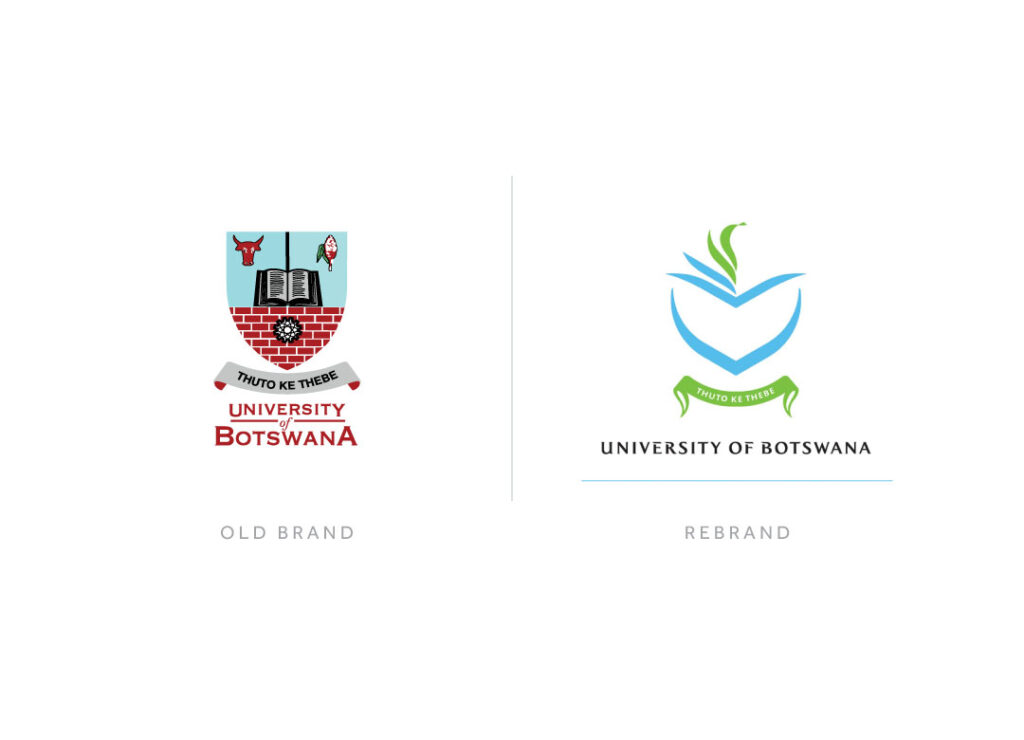
Rebrand, Botswana?
- by gmashworth
- in Branding
- posted July 2, 2016
I recently read an article in the Botswana Gazette with regards to whether rebranding is advisable. Rebranding has become popular in Botswana over recent years with several prominent organisations having rebranded. Unfortunately, not all rebrands have been successful, as Mr Gaorekwe Gaorekwe (Director, Brand Botswana) pointed out by citing the University of Botswana (UB) as an example of rebranding gone wrong. The rebrand received heavy criticism, which resulted in the University reverting back to its original crest. As a result, branding and rebranding exercises in Botswana are now subject to heavy public scrutiny.
Rebranding is a challenging process, but if done right and for the right reasons, it can be rewarding. The logo is the brand’s identity and therefore on the front line, and the reason why it receives the most attention when a rebrand is introduced. It’s all too easy to blame the designer when a rebrand fails, but I feel there are certain factors that influence the creative development and can contribute to the failure – factors that can often be overlooked.
In my opinion, the University’s motivation to rebrand and change their crest was justified, as the original is old-fashioned and needed modernising. If the university were starting out today, would this be the brand identity they would come up with? The rebranded shield was created out of the bull’s horns; the book was opened and placed on top of the shield. Its pages opened up to new leaves that incorporated the sorghum head from the old logo, symbolising a new beginning. I actually believe the rebranded crest was well designed and professionally crafted; however, the final concept was too far removed from the original and the execution too abstract.

So what else can compromise the creative process?
A vital part for any rebranding project (or any design project for that matter) is the brief. This is the starting point and where an organisation summarises why they feel the rebrand is necessary. What problem are they trying to solve? What message are they trying to communicate? In order to construct an adequate brief, one must understand the concept of branding and what it is they are trying to achieve.
Mr Gaorekwe said, when commenting on whether he feels companies in Botswana fully understand the concept of rebranding, “…I cannot say whether they do or don’t, but I hope proper research and thorough consultation takes place before rebranding.” Unfortunately thorough research and consultation isn’t always conducted, as was the case with the recent Botswana 50th Anniversary logo fiasco. However, the final design can only really be measured on the back of knowing how the brief was interpreted.
Understandably, graphic design in general is not fully understood by those who haven’t been directly exposed to it. Some people have limited to zero experience of working with a professional graphic designer; therefore their approach can be intensely business-like and formal. Although a professional graphic designer is running a business, their approach is normally informal – whilst remaining professional. The formalities of the corporate world can be an unnecessary distraction and wasteful of precious time. The key is to work smarter, not harder.
Design by committee
Larger organisations undertaking a rebrand will usually create a committee, delegating responsibility to a number of departmental representatives. Projects that are “designed by committee” can often fail to achieve the optimum outcome. This is because too many people are directly involved, which makes it difficult for ideas to be exchanged effectively and efficiently. Mr Gaorekwe indirectly touched on this aspect – “…in most cases, the process is undertaken by agencies/consultants who understand the concept very well. There are however instances where internal influence disregards the advice given by consultants who are very well versed with the subject. This often results in the exercise being compromised.”

More often than not, expert advice can be vetoed through a lack of understanding or, to be brutally honest, professional arrogance. There’s also the risk of internal politics; personalities can clash, discussions can become debates and disputes can be transferred to situations such as rebranding committees. Ideally, I feel no more than 2-3 people who are focused and inspired should have direct involvement. One person is then elected the project leader and effectively manages the process. He or she should try to minimise group dialogues and solicit ideas and feedback individually. This might even give them a sense of ownership and a feeling that their participation is valued. Once feedback is collected, the project leader can have meaningful and focused discussions with the designer.
Know your audience. Know your history
Another vital factor to consider is the target audience and anticipating their expectations. In terms of the UB rebrand, the majority of Batswana have a strong emotional connection with the University and its history. The history of the University can be found via Wikipedia (click here).
In short, the university was established in 1982 on the back of a fundraising campaign to raise money for the construction of the Botswana Campus. Batswana and other stakeholders made contributions including cash, cattle, grain, eggs, etc. towards raising the required funds. Generations of Batswana assisted in the construction and their children/grand-children are UB graduates, all generations are passionate and proud of their university. Sadly, the abstract nature of the redesign did not convey the same sentiment or heritage from the original crest.
Admittedly, some rebrands are well managed, researched and organised, yet the final product is not well received. It can be hit or miss. Although, you have to account for people who oppose change and want to keep things the way they are. Of course, the quality of the final artwork relies on the idea and the execution. The execution relies on the talent and skill of the designer and/or the agency. The process of selecting the right designer/agency (particularly through tender processes) and assessing their ability is another topic altogether.






Comments
O’Brien
February 3, 2018 at 2:01 pmMy favourite topic of discussion…. and you have summed up most points I usually fail to align words well enough to convey the message accordingly and even gave me a bit more insight on what is to be expected from the client (if I should call them that). Thank you Gary
Gabriella
March 14, 2018 at 8:37 amBookmarked!! I love your website!
Matias
March 27, 2018 at 8:25 amEverything you come up with hits a nerve with me, thanks for challenging your followers.